Exploring the Spatial Variation Characteristics and Influencing Factors of PM2.5 Pollution in China: Evidence from 289 Chinese Cities
Abstract
1. Introduction
2. Data Sources and Methods
2.1. The Study Area
2.2. The Selected Explanatory Variables and Data Sources
2.3. Methods
2.3.1. Spatial Autocorrelation Analysis Based on Moran’s I
2.3.2. Global Regression Model
2.3.3. Local Regression Model
3. Results
3.1. Spatial Variation Characteristics of PM2.5 Pollution and the Selected Explanatory Variables
3.2. Spatial Agglomeration of PM2.5 Pollution Based on Moran’s I
3.3. Analysis of the Relationship Between PM2.5 Pollution and the Explanatory Variables Based on Regression Models
4. Discussion
5. Conclusions
Author Contributions
Funding
Conflicts of Interest
References
- Spengler, J.D.; Fay, M.E.; Ferris, B.G.; Dockery, D.W.; Ware, J.H.; Pope, C.A.; Xu, X.; Speizer, F.E. An Association between Air Pollution and Mortality in Six U.S. Cities. New Engl. J. Med. 1993, 329, 1753–1759. [Google Scholar]
- Mayer, H. Air pollution in cities. Atmospheric Environ. 1999, 33, 4029–4037. [Google Scholar] [CrossRef]
- Lelieveld, J.; Evans, J.S.; Fnais, M.; Giannadaki, D.; Pozzer, A. The contribution of outdoor air pollution sources to premature mortality on a global scale. Nature 2015, 525, 367–371. [Google Scholar] [CrossRef] [PubMed]
- Ning, G.; Wang, S.; Ma, M.; Ni, C.; Shang, Z.; Wang, J.; Li, J. Characteristics of air pollution in different zones of Sichuan Basin, China. Sci. Total. Environ. 2018, 612, 975–984. [Google Scholar] [CrossRef] [PubMed]
- Peters, I.M.; Karthik, S.; Liu, H.; Buonassisi, T.; Nobre, A. Urban haze and photovoltaics. Energy Environ. Sci. 2018, 11, 3043–3054. [Google Scholar] [CrossRef]
- Silver, B.; Reddington, C.L.; Arnold, S.R.; Spracklen, D.V.; Reddington, C.; Arnold, S. Substantial changes in air pollution across China during 2015–2017. Environ. Res. Lett. 2018, 13, 114012. [Google Scholar] [CrossRef]
- Zhao, S.; Liu, S.; Hou, X.; Beazley, R.; Sun, Y. Identifying the contributions of multiple driving forces to PM10–2.5 pollution in urban areas in China. Sci. Total. Environ. 2019, 663, 361–368. [Google Scholar] [CrossRef]
- Polezer, G.; Tadano, Y.S.; Siqueira, H.V.; Godoi, A.F.; Yamamoto, C.I.; De Andre, P.A.; Pauliquevis, T.; Andrade, M.D.F.; Oliveira, A.; Saldiva, P.H.; et al. Assessing the impact of PM2.5 on respiratory disease using artificial neural networks. Environ. Pollut. 2018, 235, 394–403. [Google Scholar] [CrossRef]
- Suleiman, A.; Tight, M.R.; Quinn, A.D. Applying machine learning methods in managing urban concentrations of traffic-related particulate matter (PM10 and PM2.5). Atmos. Pollut. 2018, 10, 134–144. [Google Scholar] [CrossRef]
- Williams, A.M.; Phaneuf, D.J.; Barrett, M.A.; Su, J.G. Short-term impact of PM2.5 on contemporaneous asthma medication use: behavior and the value of pollution reductions. P. Natl. Acad. Sci. USA. 2019, 116, 5246–5253. [Google Scholar] [CrossRef]
- Bautista, L. Cardiovascular impact of PM2.5 from the emissions of coal-fired power plants in Spain during 2014 Impacto cardiovascular del PM2.5 procedente de las emisiones de las centrales térmicas de carbón en España durante el año 2014. Med. Clin-Barcelona. 2019, 153, 100–105. [Google Scholar]
- Schmitt, L.H.M. QALY gain and health care resource impacts of air pollution control: A Markov modelling approach. Environ. Sci. Policy 2016, 63, 35–43. [Google Scholar] [CrossRef]
- Cakmak, S.; Hebbern, C.; Cakmak, J.D.; Vanos, J. The modifying effect of socioeconomic status on the relationship between traffic, air pollution and respiratory health in elementary schoolchildren. J. Environ. Manag. 2016, 177, 1–8. [Google Scholar] [CrossRef] [PubMed]
- Dabass, A.; Talbott, E.O.; Bilonick, R.A.; Rager, J.R.; Venkat, A.; Marsh, G.M.; Duan, C.; Xue, T. Using spatio-temporal modeling for exposure assessment in an investigation of fine particulate air pollution and cardiovascular mortality. Environ. Res. 2016, 151, 564–572. [Google Scholar] [CrossRef] [PubMed]
- Zhu, G.; Hu, W.; Liu, Y.; Cao, J.; Ma, Z.; Deng, Y.; Sabel, C.E.; Wang, H. Health burdens of ambient PM2.5 pollution across Chinese cities during 2006–2015. J. Environ. Manag. 2019, 243, 250–256. [Google Scholar] [CrossRef] [PubMed]
- Dabass, A.; Talbott, E.; Rager, J.; Marsh, G.; Venkat, A.; Holguin, F.; Sharma, R. Systemic inflammatory makers associated with cardiovascular disease and acute and chronic exposure to fine particulate matter air pollution (PM2.5) among US NHANES adults with metabolic syndrome. Environ. Res. 2018, 161, 485–491. [Google Scholar] [CrossRef] [PubMed]
- Lv, B. Characterizations of PM2.5 Pollution Pathways and Sources Analysis in Four Large Cities in China. Aerosol Air Qual. Res. 2015, 15, 1836–1843. [Google Scholar] [CrossRef]
- Liao, T.; Wang, S.; Ai, J.; Gui, K.; Duan, B.; Zhao, Q.; Zhang, X.; Jiang, W.; Sun, Y. Heavy pollution episodes, transport pathways and potential sources of PM2.5 during the winter of 2013 in Chengdu (China). Sci. Total. Environ. 2017, 584, 1056–1065. [Google Scholar] [CrossRef]
- Du, Y.; Sun, T.; Peng, J.; Fang, K.; Liu, Y.; Yang, Y.; Wang, Y. Direct and spillover effects of urbanization on PM2.5 concentrations in China’s top three urban agglomerations. J. Clean. Prod. 2018, 190, 72–83. [Google Scholar] [CrossRef]
- Kuula, J.; Kuuluvainen, H.; Rönkkö, T.; Niemi, J.V.; Saukko, E.; Portin, H.; Aurela, M.; Saarikoski, S.; Rostedt, A.; Hillamo, R.; et al. Applicability of Optical and Diffusion Charging-Based Particulate Matter Sensors to Urban Air Quality Measurements. Aerosol Air Qual. Res. 2019, 19, 1024–1039. [Google Scholar] [CrossRef]
- Xu, C.; Wu, S. Evaluating the Effects of Household Characteristics on Household Daily Traffic Emissions Based on Household Travel Survey Data. Sustainability 2019, 11, 1684. [Google Scholar] [CrossRef]
- Ngo, N.S.; Asseko, S.V.J.; Ebanega, M.O.; Allo’O, S.M.A.; Hystad, P. The relationship among PM2.5, traffic emissions, and socioeconomic status: Evidence from Gabon using low-cost, portable air quality monitors. Transp. Res. Part D: Transp. Environ. 2019, 68, 2–9. [Google Scholar] [CrossRef]
- Hao, Y.; Liu, Y.-M. The influential factors of urban PM2.5 concentrations in China: a spatial econometric analysis. J. Clean. Prod. 2016, 112, 1443–1453. [Google Scholar] [CrossRef]
- Shen, G. Changes from traditional solid fuels to clean household energies – Opportunities in emission reduction of primary PM2.5 from residential cookstoves in China. Biomass Bioenerg. 2016, 86, 28–35. [Google Scholar] [CrossRef]
- Lai, A.; Shan, M.; Deng, M.; Carter, E.; Yang, X.; Baumgartner, J.; Schauer, J. Differences in chemical composition of PM2.5 emissions from traditional versus advanced combustion (semi-gasifier) solid fuel stoves. Chemosphere 2019, 233, 852–861. [Google Scholar] [CrossRef] [PubMed]
- Fenech, S.; Doherty, R.M.; Heaviside, C.; MacIntyre, H.L.; O’Connor, F.M.; Vardoulakis, S.; Neal, L.; Agnew, P. Meteorological drivers and mortality associated with O3 and PM2.5 air pollution episodes in the UK in 2006. Atmospheric Environ. 2019, 213, 699–710. [Google Scholar] [CrossRef]
- Alvarez, H.A.O.; Myers, O.B.; Weigel, M.; Armijos, R.X. The value of using seasonality and meteorological variables to model intra-urban PM2.5 variation. Atmospheric Environ. 2018, 182, 1–8. [Google Scholar] [CrossRef] [PubMed]
- Zalakeviciute, R.; Lopez-Villada, J.; Rybarczyk, Y. Contrasted Effects of Relative Humidity and Precipitation on Urban PM2.5 Pollution in High Elevation Urban Areas. Sustainability 2018, 10, 2064. [Google Scholar] [CrossRef]
- Ryu, J.; Kim, J.J.; Byeon, H.; Go, T.; Lee, S.J. Removal of fine particulate matter (PM2.5) via atmospheric humidity caused by evapotranspiration. Environ. Pollut. 2019, 245, 253–259. [Google Scholar] [CrossRef]
- De Hoogh, K.; Héritier, H.; Stafoggia, M.; Künzli, N.; Kloog, I. Modelling daily PM2.5 concentrations at high spatio-temporal resolution across Switzerland. Environ. Pollut. 2018, 233, 1147–1154. [Google Scholar] [CrossRef]
- Rahman, A.; Luo, C.; Khan, M.; Ke, J.; Thilakanayaka, V.; Kumar, S. Influence of atmospheric PM2.5, PM10, O3, CO, NO2, SO2, and meteorological factors on the concentration of airborne pollen in Guangzhou. China. Atmos. Environ. 2019, 212, 290–304. [Google Scholar]
- Miettinen, M.; Leskinen, A.; Abbaszade, G.; Orasche, J.; Sainio, M.; Mikkonen, S.; Koponen, H.; Rönkkö, T.; Ruusunen, J.; Kuuspalo, K.; et al. PM2.5 concentration and composition in the urban air of Nanjing, China: Effects of emission control measures applied during the 2014 Youth Olympic Games. Sci. Total. Environ. 2019, 652, 1–18. [Google Scholar] [CrossRef] [PubMed]
- Jia, S.; Sarkar, S.; Zhang, Q.; Wang, X.; Wu, L.; Chen, W.; Huang, M.; Zhou, S.; Zhang, J.; Yuan, L.; et al. Characterization of diurnal variations of PM2.5 acidity using an open thermodynamic system: A case study of Guangzhou, China. Chemosphere 2018, 202, 677–685. [Google Scholar] [CrossRef] [PubMed]
- Wang, Q.; Kwan, M.-P.; Zhou, K.; Fan, J.; Wang, Y.; Zhan, D. Impacts of residential energy consumption on the health burden of household air pollution: Evidence from 135 countries. Energy Policy 2019, 128, 284–295. [Google Scholar] [CrossRef]
- Jia, R.; Khadka, A.; Kim, I. Traffic crash analysis with point-of-interest spatial clustering. Accid. Anal. Prev. 2018, 121, 223–230. [Google Scholar] [CrossRef]
- Guo, S.; Lu, J. Jurisdictional air pollution regulation in China: A tragedy of the regulatory anti-commons. J. Clean. Prod. 2019, 212, 1054–1061. [Google Scholar] [CrossRef]
- Oshan, T.; Wolf, L.J.; Fotheringham, A.S.; Kang, W.; Li, Z.; Yu, H. A comment on geographically weighted regression with parameter-specific distance metrics. Int. J. Geogr. Inf. Sci. 2019, 33, 1289–1299. [Google Scholar] [CrossRef]
- Chen, J.; Zhou, C.; Wang, S.; Hu, J. Identifying the socioeconomic determinants of population exposure to particulate matter (PM2.5) in China using geographically weighted regression modeling. Environ. Pollut. 2018, 241, 494–503. [Google Scholar] [CrossRef]
- Arabameri, A.; Pradhan, B.; Rezaei, K. Gully erosion zonation mapping using integrated geographically weighted regression with certainty factor and random forest models in GIS. J. Environ. Manag. 2019, 232, 928–942. [Google Scholar] [CrossRef]
- Chen, Q.; Mei, K.; Dahlgren, R.A.; Wang, T.; Gong, J.; Zhang, M. Impacts of land use and population density on seasonal surface water quality using a modified geographically weighted regression. Sci. Total. Environ. 2016, 572, 450–466. [Google Scholar] [CrossRef]
- Hajiloo, F.; Hamzeh, S.; Gheysari, M. Impact assessment of meteorological and environmental parameters on PM2.5 concentrations using remote sensing data and GWR analysis (case study of Tehran). Environ. Sci. Pollut. Res. 2019, 26, 24331–24345. [Google Scholar] [CrossRef] [PubMed]
- Salvati, L.; Ciommi, M.T.; Serra, P.; Chelli, F.M. Exploring the spatial structure of housing prices under economic expansion and stagnation: The role of socio-demographic factors in metropolitan Rome, Italy. Land Use Policy 2019, 81, 143–152. [Google Scholar] [CrossRef]
- The Chinese Air Quality Online Monitoring Platform. Query of Historical Data of Air Quality 2019. Available online: from http://www.aqistudy.cn/historydata/ (accessed on 18 July 2019).
- Ministry of Ecology and Environment of the People’s Republic of China. 2019. Available online: http://www.mee.gov.cn (accessed on 18 July 2019).
- Ministry of Ecology and Environment of the People’s Republic of China. Ambient Air Quality Standards. National Environmental Protection Standards of the People’s Republic of China 2012, (GB3095-2012). Available online: http://kjs.mee.gov.cn/hjbhbz/bzwb/dqhjbh/dqhjzlbz/201203/t20120302_224165.shtml (accessed on 18 July 2019).
- Xu, Y.; Duan, J.; Xu, X. Comprehensive methods for measuring regeional multidimensional development and their applications in China. J. Geogr. Sci. 2018, 28, 1182–1196. [Google Scholar] [CrossRef]
- Habibi, R.; Alesheikh, A.; Mohammadinia, A.; Sharif, M. An Assessment of Spatial Pattern Characterization of Air Pollution: A Case Study of CO and PM2.5 in Tehran, Iran. ISPRS. Int. J. Geo-Inf. 2017, 6, 270. [Google Scholar] [CrossRef]
- Li, M.; Li, C.; Zhang, M. Exploring the spatial spillover effects of industrialization and urbanization factors on pollutants emissions in China’s Huang-Huai-Hai region. J. Clean. Prod. 2018, 195, 154–162. [Google Scholar] [CrossRef]
- Kowe, P.; Mutanga, O.; Odindi, J.; Dube, T. Exploring the spatial patterns of vegetation fragmentation using local spatial autocorrelation indices. J. Appl. Remote Sens. 2019, 13, 024523. [Google Scholar] [CrossRef]
- Chou, A.K.; Chen, D.R. Socioeconomic status and deaths due to unintentional injury among children: A socio-spatial analysis in Taiwan. Geospat. Heal. 2019, 14, 25–34. [Google Scholar] [CrossRef]
- Dekavalla, M.; Argialas, D. A Region Merging Segmentation with Local Scale Parameters: Applications to Spectral and Elevation Data. Remote. Sens. 2018, 10, 2024. [Google Scholar] [CrossRef]
- Tian, W.; Song, J.; Li, Z. Spatial regression analysis of domestic energy in urban areas. Energy 2014, 76, 629–640. [Google Scholar] [CrossRef]
- Ahn, K.; Palmer, R. Regional flood frequency analysis using spatial proximity and basincharacteristics: quantile regression vs. parameter regression technique. J. Hydrol. 2016, 540, 515–526. [Google Scholar] [CrossRef]
- Adame-Campos, R.L.; Ghilardi, A.; Gao, Y.; Paneque-Gálvez, J.; Mas, J.-F. Variables Selection for Aboveground Biomass Estimations Using Satellite Data: A Comparison between Relative Importance Approach and Stepwise Akaike’s Information Criterion. ISPRS Int. J. Geo-Information 2019, 8, 245. [Google Scholar] [CrossRef]
- Feuillet, T.; Commenges, H.; Menai, M.; Salze, P.; Perchoux, C.; Reuillon, R.; Kesse-Guyot, E.; Enaux, C.; Nazare, J.-A.; Hercberg, S.; et al. A massive geographically weighted regression model of walking-environment relationships. J. Transp. Geogr. 2018, 68, 118–129. [Google Scholar] [CrossRef]
- Wang, Y.; Chen, W.; Kang, Y.; Li, W.; Guo, F. Spatial correlation of factors affecting CO2 emission at provincial level in China: A geographically weighted regression approach. J. Clean. Prod. 2018, 184, 929–937. [Google Scholar] [CrossRef]
- Guo, H.; Cheng, T.; Gu, X.; Wang, Y.; Chen, H.; Bao, F.; Shi, S.; Xu, B.; Wang, W.; Zuo, X.; et al. Assessment of PM2.5 concentrations and exposure throughout China using ground observations. Sci. Total. Environ. 2017, 601, 1024–1030. [Google Scholar] [CrossRef] [PubMed]
- Wong, Y.K.; Huang, X.H.; Cheng, Y.Y.; Louie, P.K.; Yu, A.L.; Tang, A.W.; Chan, D.H.; Yu, J.Z. Estimating contributions of vehicular emissions to PM2.5 in a roadside environment: A multiple approach study. Sci. Total. Environ. 2019, 672, 776–788. [Google Scholar] [CrossRef] [PubMed]
- Maji, K.J.; Ye, W.-F.; Arora, M.; Nagendra, S.S. PM2.5-related health and economic loss assessment for 338 Chinese cities. Environ. Int. 2018, 121, 392–403. [Google Scholar] [CrossRef]
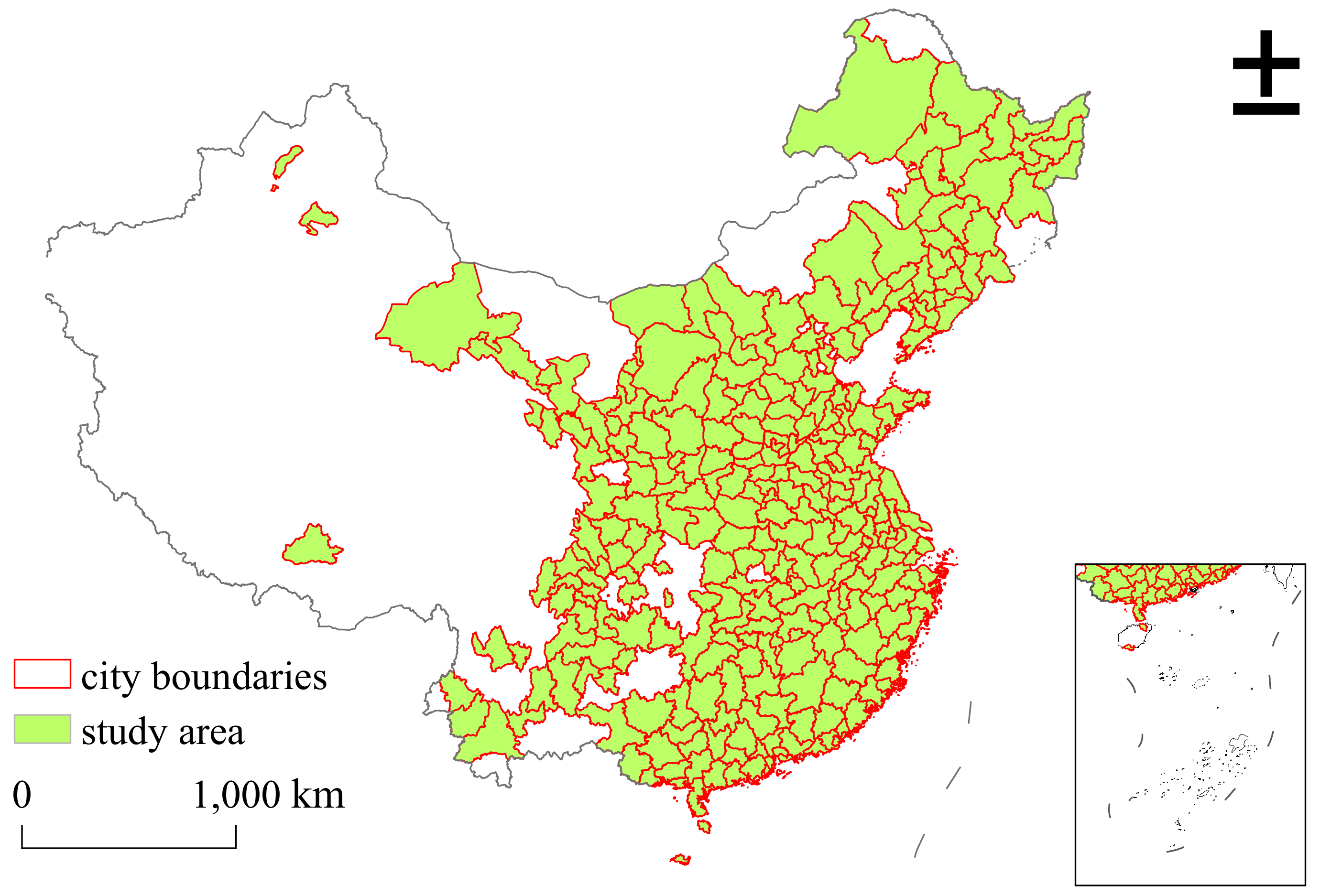
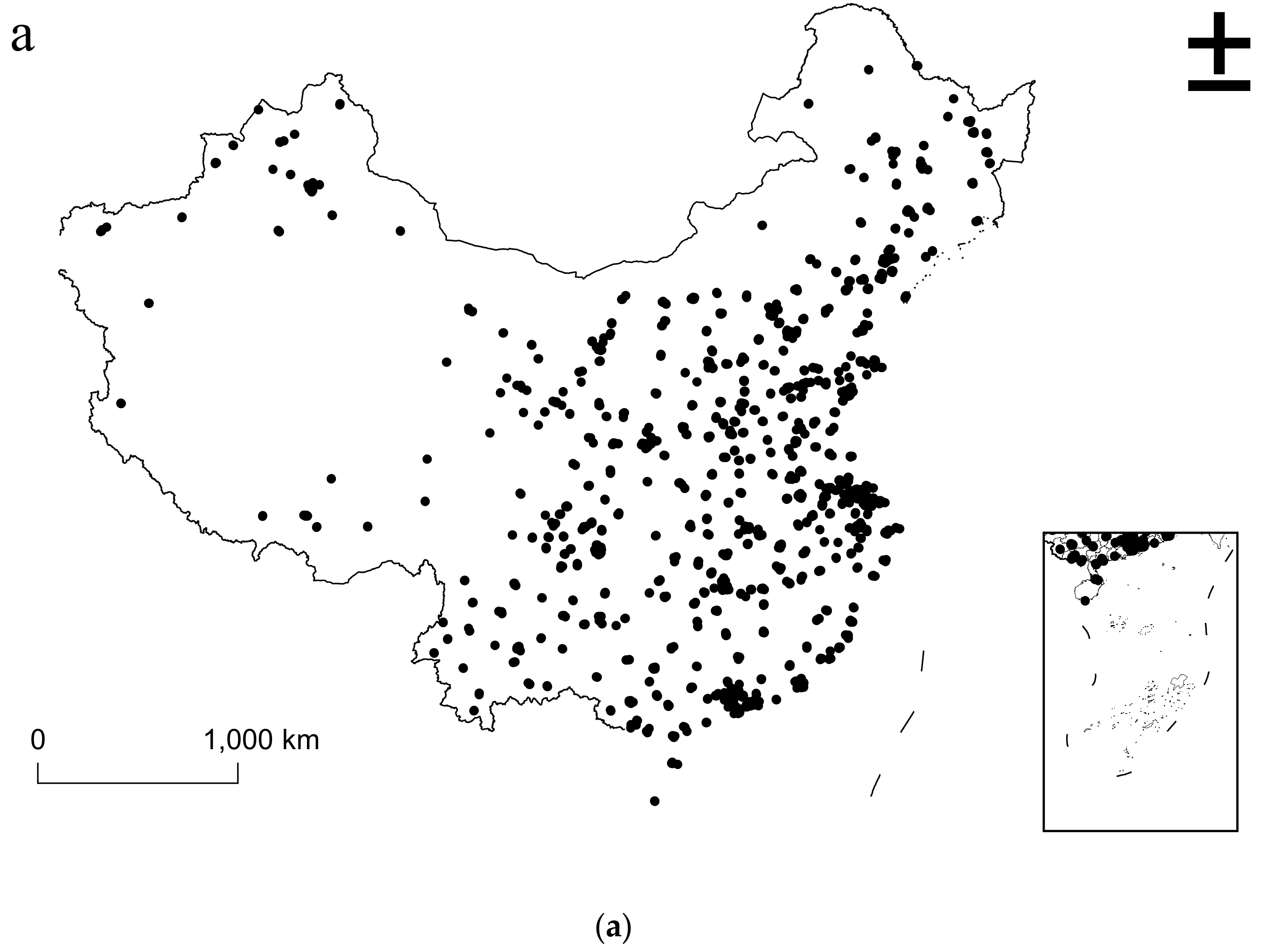
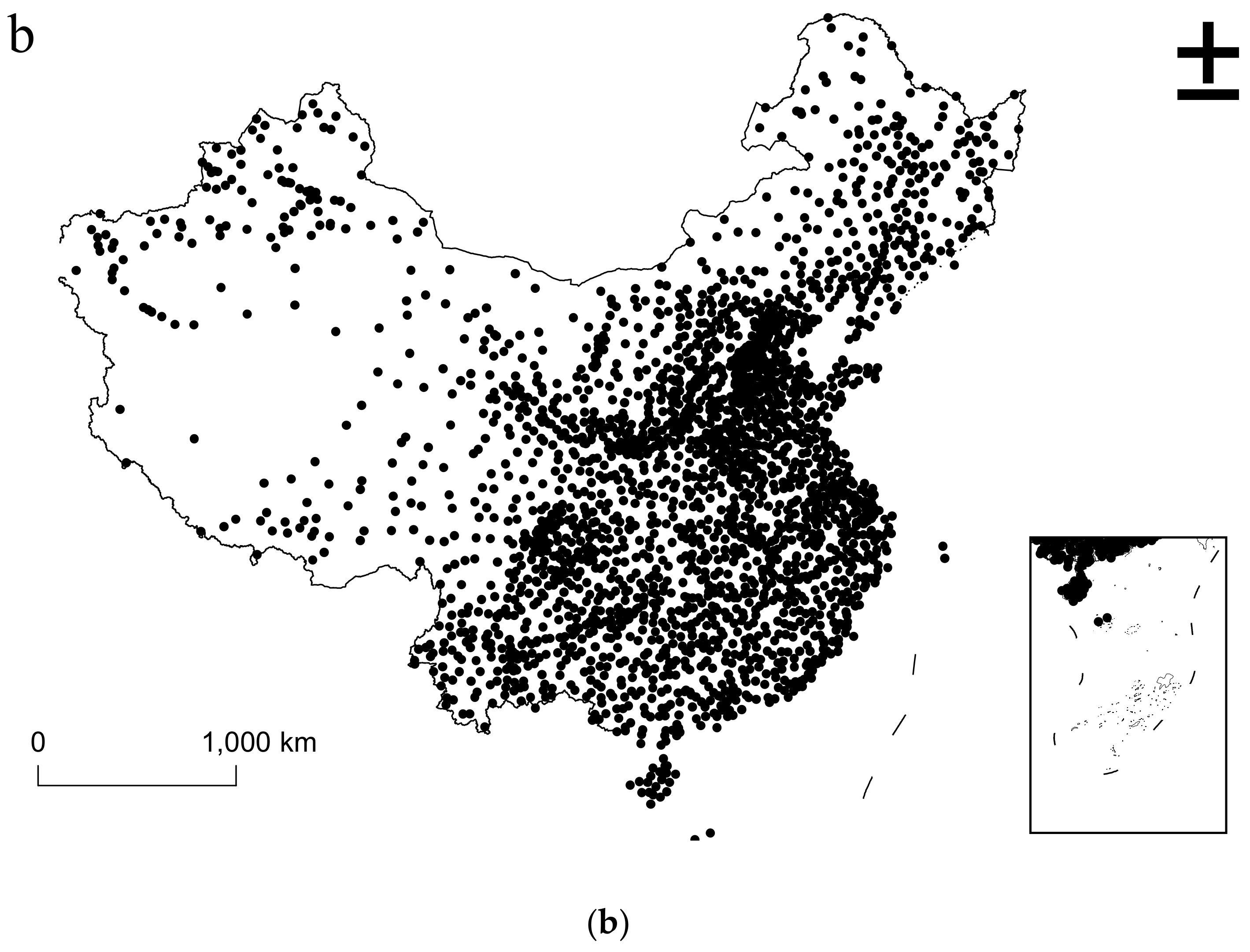
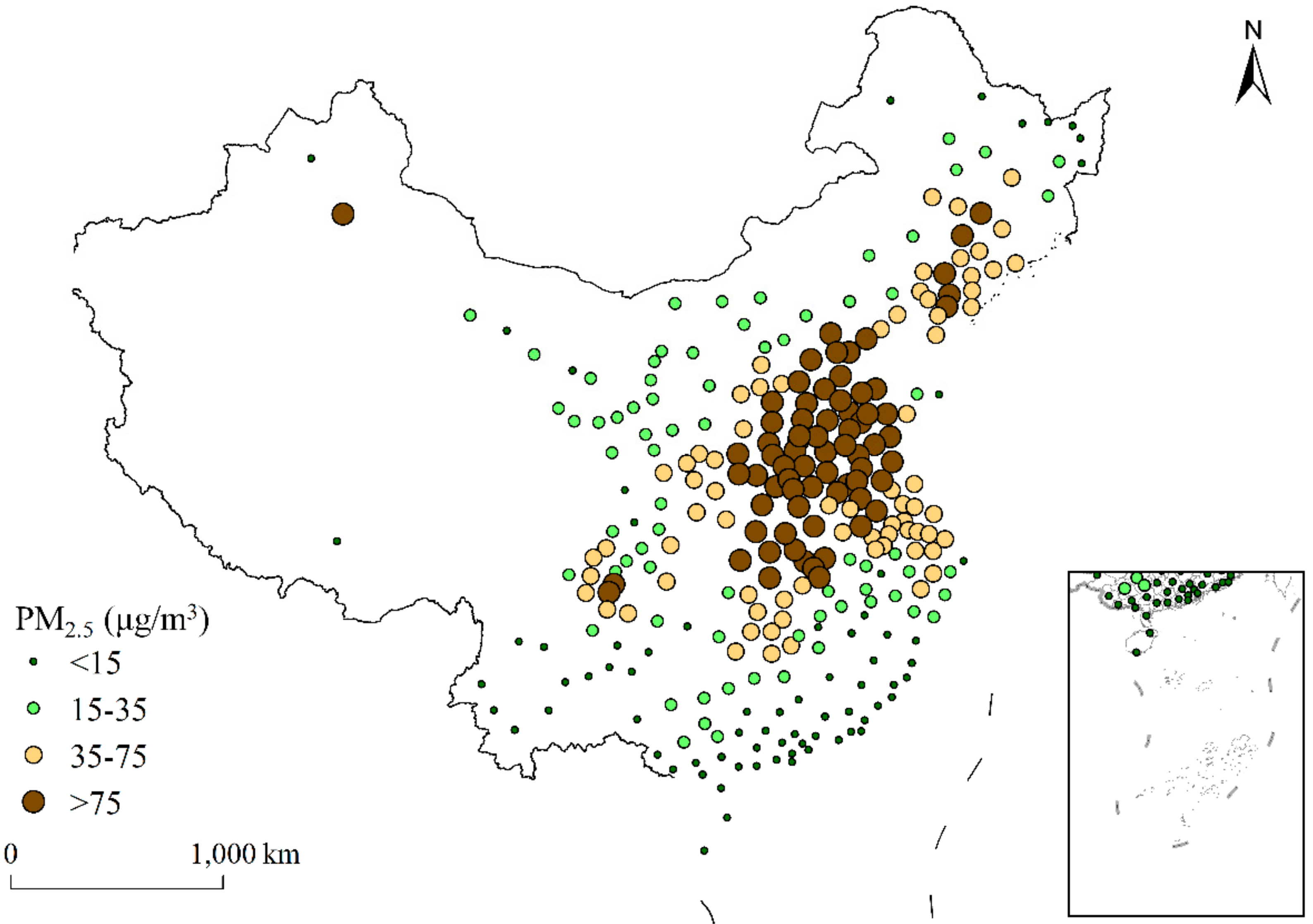
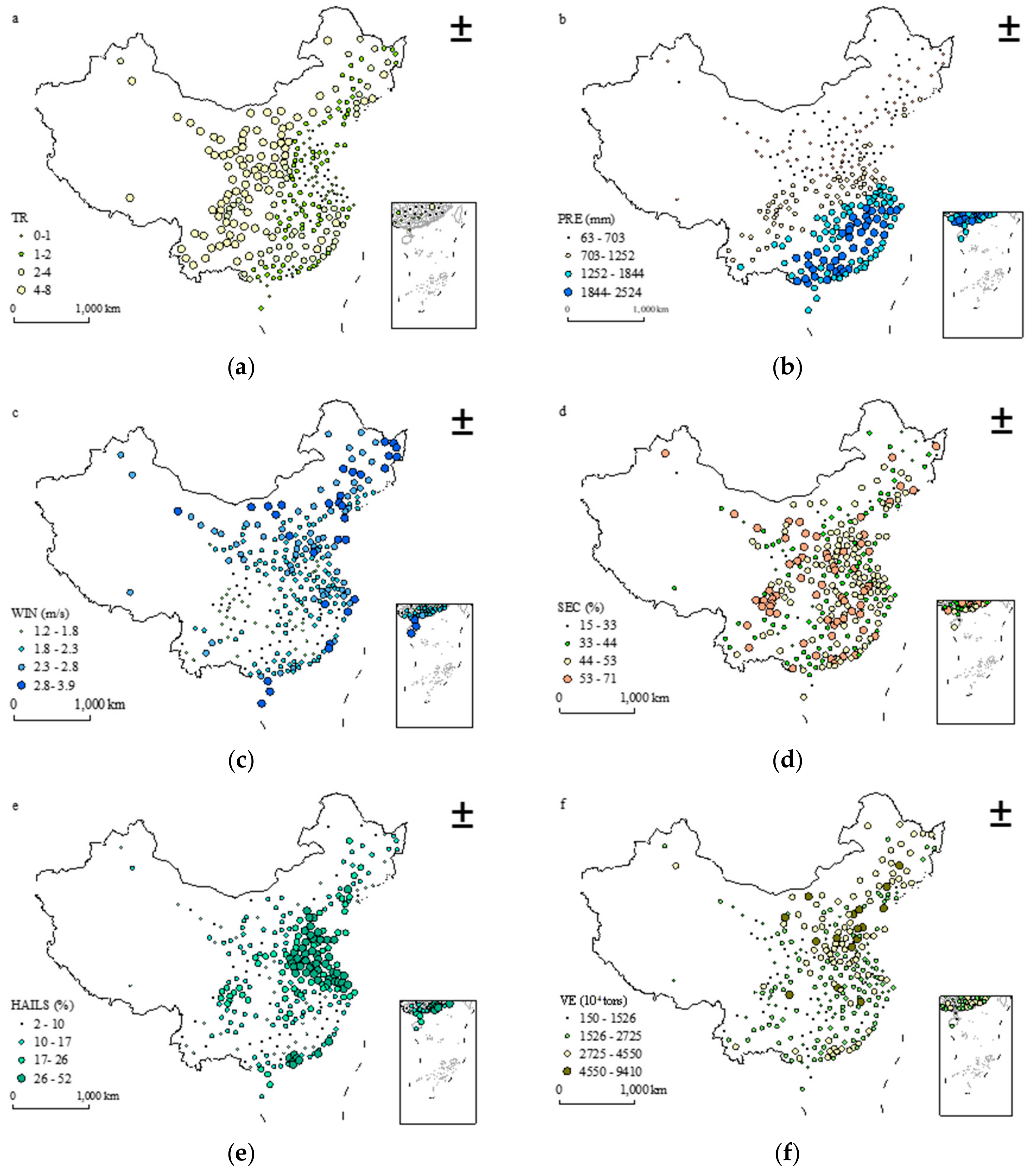
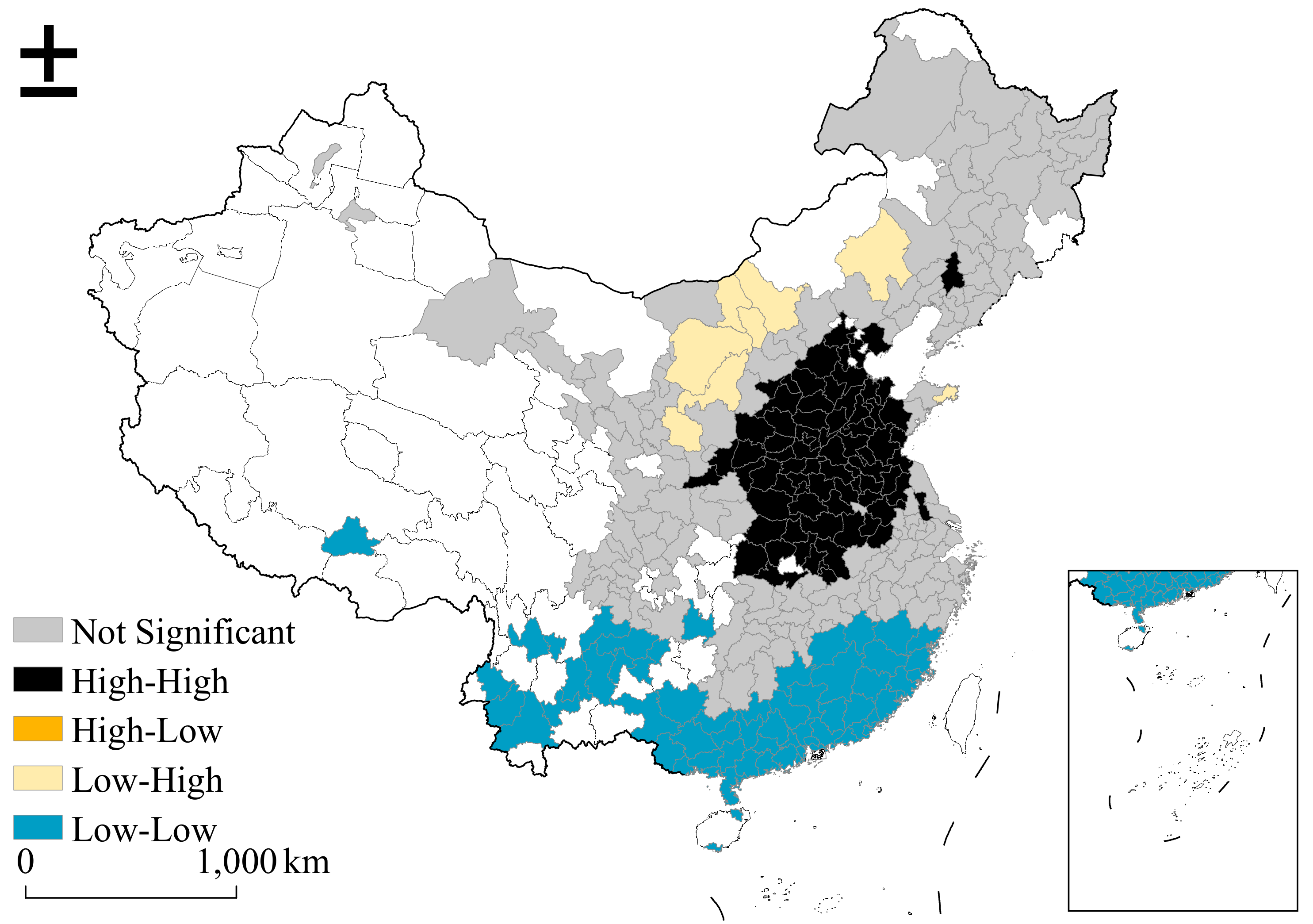
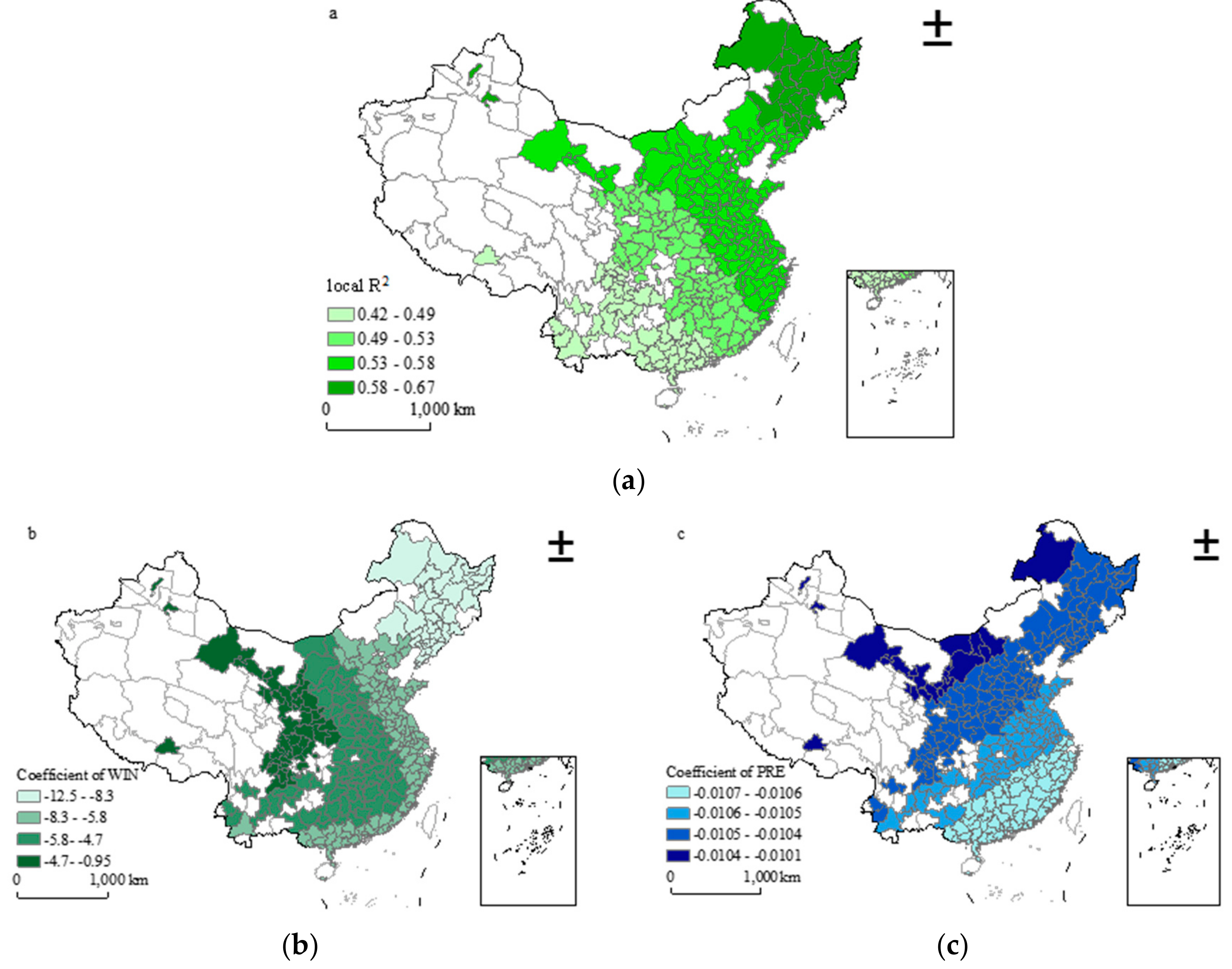
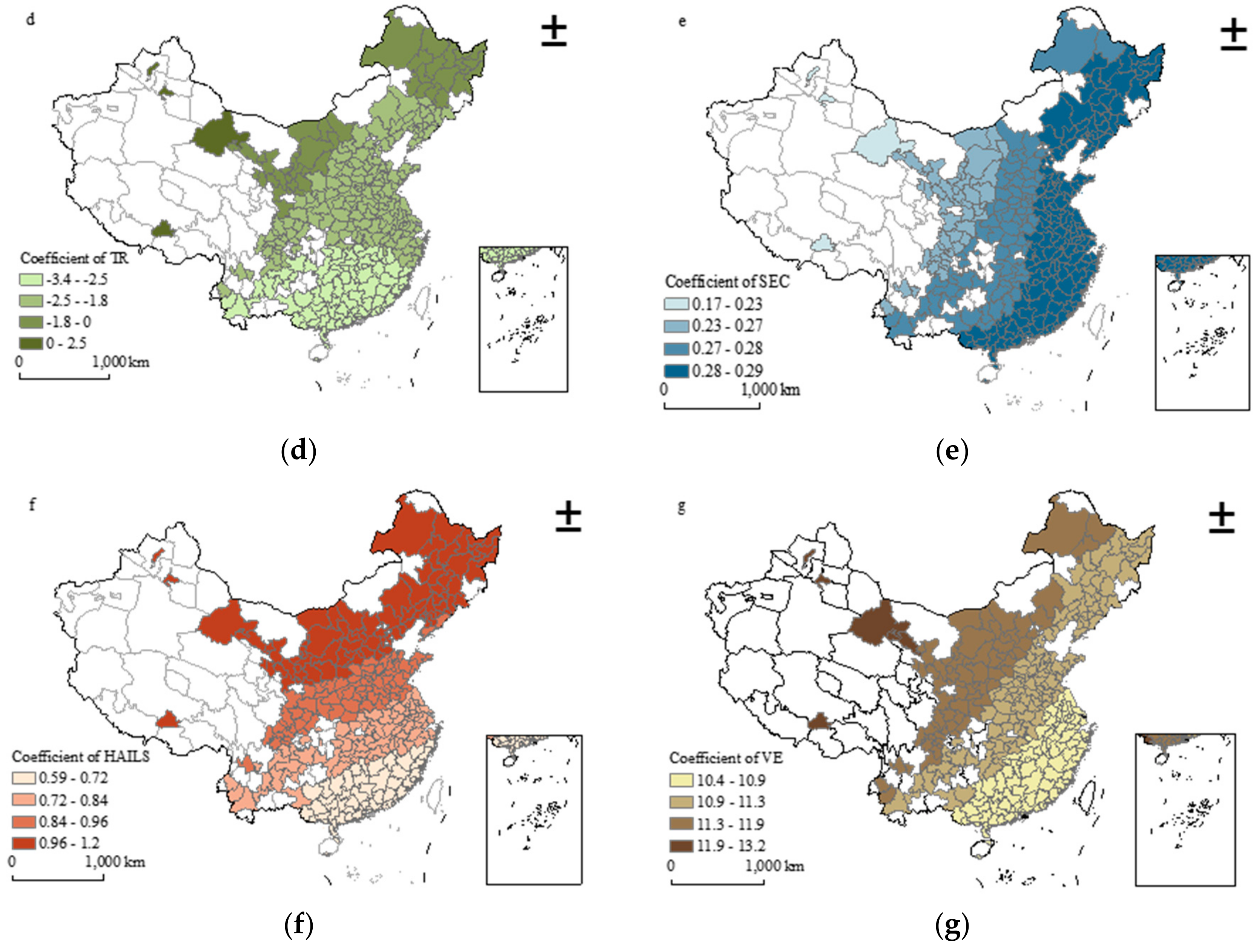
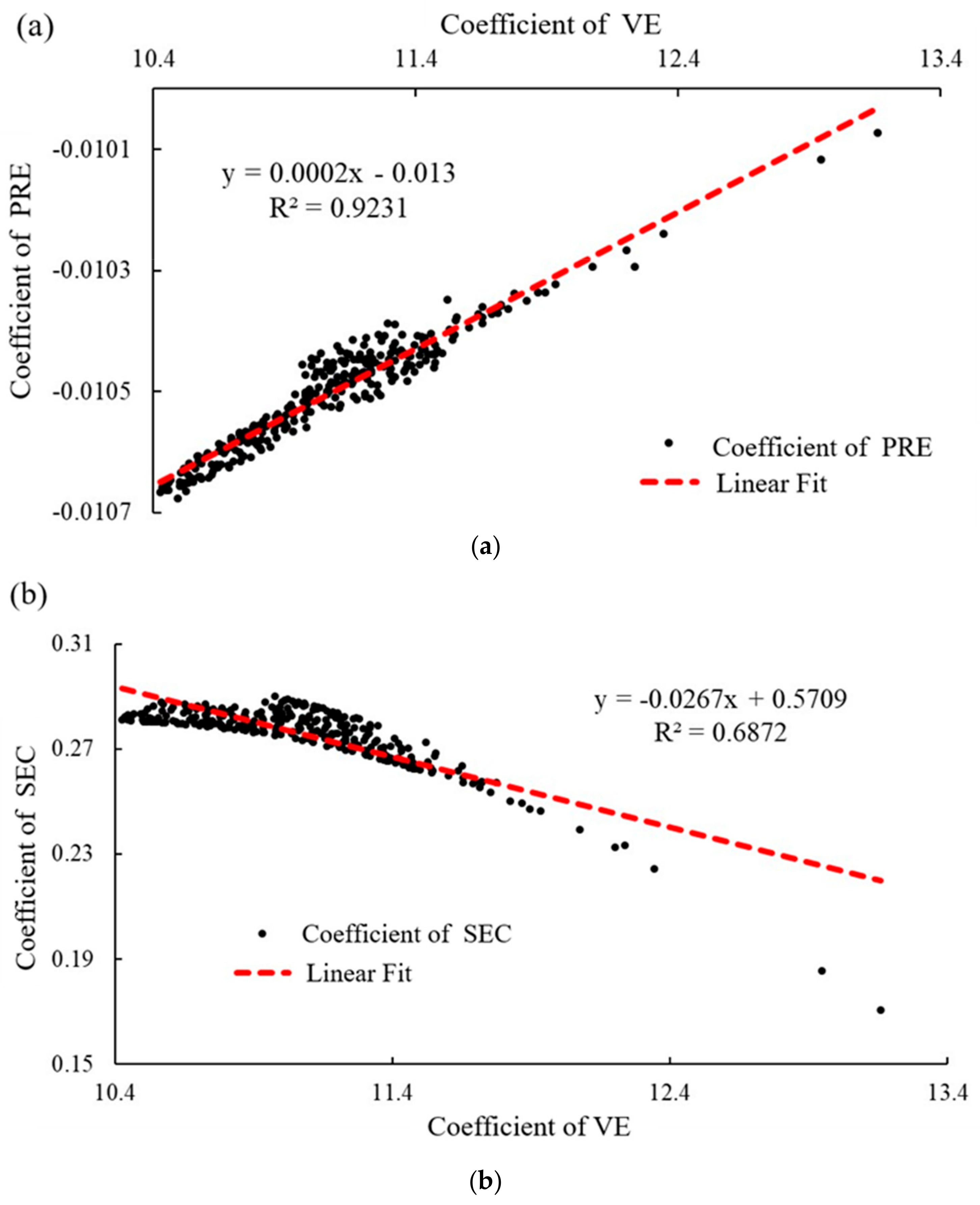
| Variables | Abbreviation | Meaning |
|---|---|---|
| Terrain relief | TR | Relief degree of topography |
| Precipitation (mm) | PRE | Sum of daily precipitation in the year 2015 |
| Wind speed (m/s) | WIN | Mean of daily average temperature |
| Human activity intensity of land surface (%) | HAILS | The extent of the impact of human activities on land surface |
| The secondary industry’s proportion (%) | SEC | The proportion of the secondary industry in the total social output value |
| The total particulate matter emissions of motor vehicles (104 tons) | VE | Total particulate matter emissions from motor vehicle exhaust |
| Concentration Limits | Annual Mean | 24-h Average |
|---|---|---|
| Level 1th | 15 | 35 |
| Level 2th | 35 | 75 |
| Variables | OLS Results | SLM Results | SEM Results |
|---|---|---|---|
| TR | −1.51 | −0.81 | −0.41 |
| WIN (m/s) | −5.82 * | −1.5 ** | −4.14 * |
| SEC (%) | 0.25 ** | 0.07 *** | 0.06 *** |
| VE (104 tons) | 8.26 * | 5.52 ** | 3.85 ** |
| PRE (mm) | −0.017 ** | −0.031 *** | −0.04 *** |
| HAILS (%) | 0.67 * | 0.32 * | 0.27 ** |
| Lag parameter | − | 0.581 ** | − |
| Lambda (spatial error parameter) | − | − | 0.592 ** |
| R-squared | 0.513 | 0.612 | 0.631 |
| AIC | 2216.83 | 1918.81 | 1808.87 |
© 2019 by the authors. Licensee MDPI, Basel, Switzerland. This article is an open access article distributed under the terms and conditions of the Creative Commons Attribution (CC BY) license (http://creativecommons.org/licenses/by/4.0/).
Share and Cite
Zhao, S.; Xu, Y. Exploring the Spatial Variation Characteristics and Influencing Factors of PM2.5 Pollution in China: Evidence from 289 Chinese Cities. Sustainability 2019, 11, 4751. https://doi.org/10.3390/su11174751
Zhao S, Xu Y. Exploring the Spatial Variation Characteristics and Influencing Factors of PM2.5 Pollution in China: Evidence from 289 Chinese Cities. Sustainability. 2019; 11(17):4751. https://doi.org/10.3390/su11174751
Chicago/Turabian StyleZhao, Shen, and Yong Xu. 2019. "Exploring the Spatial Variation Characteristics and Influencing Factors of PM2.5 Pollution in China: Evidence from 289 Chinese Cities" Sustainability 11, no. 17: 4751. https://doi.org/10.3390/su11174751
APA StyleZhao, S., & Xu, Y. (2019). Exploring the Spatial Variation Characteristics and Influencing Factors of PM2.5 Pollution in China: Evidence from 289 Chinese Cities. Sustainability, 11(17), 4751. https://doi.org/10.3390/su11174751




